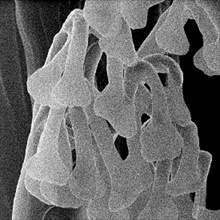Members Login

Channels
Special Offers & Promotions
Fascinating Images Reveal Climbing Abilities of Geckos and Spiders
 Scientists from
Lewis and Clark College,
working collaboratively with the Joint School of Nanoscience and
Nanoengineering (JSNN) in the USA
have examined the fascinating climbing skills of geckos and spiders using the
ORION helium ion microscope from Carl Zeiss. High resolution images displaying
unique definition and detail rendition reveal even the finest structures on the
feet of these animals. This imaging
advances the understanding of how the masterly climbing skills of these
creatures are attributable to adhesive forces or, in other words,
intermolecular attractions. The secret lies in the fine structure of the tiny
hairs, or "setae", that cover the undersides of the feet. The spatula-shaped
tips of the hairs allow the creatures to make a vast number of contacts with
the climbed surface. The simple adhesive force observed between all touching
objects enables the gecko or spider to carry many times its own weight when
climbing upside down.
Scientists from
Lewis and Clark College,
working collaboratively with the Joint School of Nanoscience and
Nanoengineering (JSNN) in the USA
have examined the fascinating climbing skills of geckos and spiders using the
ORION helium ion microscope from Carl Zeiss. High resolution images displaying
unique definition and detail rendition reveal even the finest structures on the
feet of these animals. This imaging
advances the understanding of how the masterly climbing skills of these
creatures are attributable to adhesive forces or, in other words,
intermolecular attractions. The secret lies in the fine structure of the tiny
hairs, or "setae", that cover the undersides of the feet. The spatula-shaped
tips of the hairs allow the creatures to make a vast number of contacts with
the climbed surface. The simple adhesive force observed between all touching
objects enables the gecko or spider to carry many times its own weight when
climbing upside down. Until now, it was extremely difficult to obtain images of the tiny, delicate hairs. Electron microscopes generate an electrostatic charge on the surface of practically all biological specimens. This impairs the image quality, which is why research scientists frequently cover biological specimens with a thin gold coating during preparation. This, in turn, covers up the fine structures of the gecko and spider hairs. Helium ion microscopy offers a simple but effective solution to this problem: static charge is neutralized in a very straightforward manner, allowing the specimen to be imaged in its natural state. The result: razor-sharp images that offer not only high scientific content, but also an outstanding degree of abstract beauty.
Spider samples have been provided by Dr. S. Gorb. The use of ORION®PLUS HIM at Joint School of Nanoscience and Nanoengineering (JSNN), UNC at Greensboro and NC A&T State U is acknowledged.
To download the application note please click here
Media Partners


